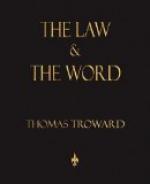Now it appears to me, that taken in this way, the Bible is an exceedingly practical book, and that is why I want the reader to get at some general principles which he will find, mutatis mutandis, equally applicable all round, whether to electricity, or to life, and whatever may be the subject-matter, it will always be found to resolve itself into a question of the relation between Law and Personality. If now we read the Bible Promises in the light of the general principles we have considered in the earlier pages, we shall find that they are all Promises according to Law. They are statements of the results to be obtained by a truer realization of the principles of Law and Personality than we have hitherto apprehended.
We must always bear in mind that the Law is set in motion by the Word. The Word does not make the Law, but gives it something to work upon, so that without the Word there could be no manifestation of the Law, a truth embodied in the maxim, that “Every Creation carries its own mathematics along with it.” If the reader remembers what I have said in the chapter of “The Soul of the Subject,” he will see that the principle involved, is that of the susceptibility of the Impersonal to suggestions from the Personal. This follows of course from the very Conception of Impersonality; it is that which has no power of selection and volition, and which is therefore without any power of taking an initiative on its own account.
In a previous chapter I have pointed out that the only possible conception of the inauguration of a world-system, resolves itself into the recognition of one original and universal Substantive Life, out of which proceeds a corresponding Verb, or active energy, reproducing in action what the Substantive is in essence. On the other hand there must be something for this active principle to work in; and since there can be nothing anterior to the Universal Life or Energy, both these factors must be potentially contained in it. If, then, we represent this Eternal Substantive Life by a circle with a dot in the centre, we may represent these two principles as emerging from it by placing two circles at equal distance below it, one on either side, and placing the sign “+” (plus) in one, and the sign “-” (minus) in the other. This is how students of these subjects usually map out the relation of the prima principia, or first abstract principles. The sign “+” (plus) indicates the Active principle, and the sign “-” (minus) the Passive principle. If the reader will draw a little diagram as described, it will help to make what follows clearer.
Necessarily the initiative must be taken by the Active principle; and the taking of initiative implies selection and volition, that is to say, the essential qualities of personality; and Passivity implies the converse of all this, and therefore is Impersonality. The two principles in no way conflict with one another, but are polar opposites, like the positive and negative plates of a battery, or the two ends of a magnet. They are complementary to one another, and neither can work without the other. A little consideration will show that this is not a mere fancy, but a self-obvious generalization, the contrary to which it is impossible to conceive. It is simply the case of the box which cannot come into existence without the activity of the carpenter and the passivity of the wood.




